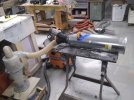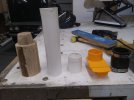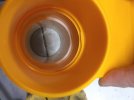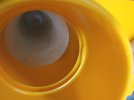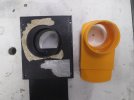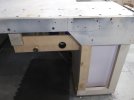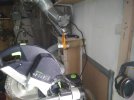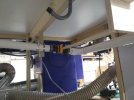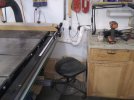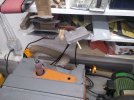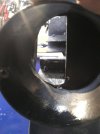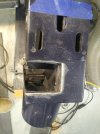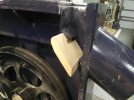Both do the job but only for the matching use case.
The big CV excels on the very high volume, big ducts, very low resistance. So for the un-modified table saw, overarm, bandsaw, jointer, planer and maybe an ambient hood for lathe or miter saw, it is the better technology.
Please consider, there is a big difference between dust and chips you can sweep up and the fine to ultra fine particles that cause lung disease. I can sweep up 10 micron dust. It falls out of the air. Actually, about once a week, I open the doors and use a leaf blower to blow all the settled dust out. Wearing my good mask of course. If you can see it, it is not what hurts you. A nuisance, but not dangerous.
For things like handheld tools, disk, spindle sander, and hose to clean everything up, a single extractor is by far superior. For the Kapex, the CV produced virtually ZERO flow as the port is less than an inch. 5 inches of lift just does not pull anything through. 90 does. So the vacuum is a must. If I wanted a hood, it would mean running both the vac and CV.
On the router, the CV was fine on the fence, but could not keep the base of the router clear. I tested an enclosure but it just can't produce the lift to clear around the bit. A single vac is OK if you keep the fence tight, but running two works great.
Running two high lift motors, a Ridgid and a Fein, through a 4 inch hose has enough flow for my jointer, planer and drum sander. One would actually work on the DeWalt planer as it has an internal high volume fan. The CV would be optimum, but both methods work.
The table saw unmodified needs the high flow. Spec of over 800 CFM and that's not counting the overarm. Tested the overarm and with the side brush mod, performance is the subjectively about same one vac vs the CV. With the saw, after I sealed the cabinet the CV would do nothing as sealed means high resistance, but two vacs have enough flow to maintain lift forcing far more flow past the insert in the gap fore and aft of the blade. I still get cabinet drop-out, but less comes back on top of the table. Further in-cabinet mods will reduce it more. That leaves the additional volume from the third motor to run the overarm. Rippling half a blade width does still jet across the table and that can be fine dust. The only solution I have is either the magnetic hose scoop I occasionally set up, or the correct solution may be a port in the surface of the table. I can envision a 3 x 6 insert perforated left of and a couple inches away from the blade to suck down that jet. Do I dare cut a hole in my table top?
I have made internal tweaks to my band saw where it is a wash, CV, 6 inch to two 4 inch vs two motors, 4 inch split to two. I have further mods in mind where high lift is better. So both work OK.
So, two systems would be optimal, but can I do it with ONE system? For my specific case, yes. The tipping point was to modify the duct collection internal to the table saw where high flow was no longer needed and high lift works better.
As I have the CV, one might think keeping it on a 6 inch system and keeping the Fein/CD cyclone as the 2 inch system is best. Yes and no. Space is the issue. I could move the Fein system upstairs as it has enough lift to overcome 10 feet and it already has a "true HEPA" filter. Note "true HEPA is not as fine as H13 medical grade HEPA. Lots to be learned there but that's another topic. I then still have to build a cabinet around the CV with HEPA filters as it's big filters are only MERV 15 so they pass the ultra fine dust that is most dangerous. WYNN makes some good ones, but I need at least three @ $350 each to get the flow with less than one inch drop. The alternative is to sacrifice the HVAC and blow the CV outside. With no filters, it would pick up an inch of lift.
As a single vac does not move much volume, sending the exhaust outside may be a very good implementation. Tools like the ROS are the worst for making ultra fine dust, maybe even one's track saw. Best filter is one you don't need. Might need a muffler though if using in noise restriction hours. Moving the CV outside would cause anyone on the street to come knocking as it is as bad as a commercial gas powered leaf blower. It would also devastate my attempt to hold RH around 50% ands comfortable temps.
So I go with the Record Power three motor. I can get away with one H13 external filter. I regain space I need. If I did more volume jointing and planning, or maybe had a bigger planer that could take off more than a hair, needed a big sanding hood by the lathe or had any hope of better collection around the Kapex, then keeping the CV would be best.
By measurement, I was getting around 1200 CFM at the entrance to my table saw with no other port open. Add the overarm and it dropped more. I still need to add a H13 filter box for well over $1000 and it will reduce the flow further. The three motor Record can pull 850 CFM through a 4 inch duct they claim ( seems high to me) so it is not really that far short. A pair of two motor systems might actually out-perform the CV in all cases. Something to think about.
The 2 inch system is currently fed by just the Fein. I did mock-ups with the two vacs on the larger machines and drug out my old Sears vac for three on the table saw. Had to run an extension cord to get enough 110 power. An advantage of the Record is it runs on 220, so I have the power without re-wiring.
It is clear the industry has not given enough thought and effort to ultra fine dust collection for small shop. OSHA has nothing to say about my hobby, but they do for commercial shops. Enclosed CNC is becoming the norm. Even so, standards are too lax. They have been reducing PM2.5 every couple of years but no real spec on over 90 % of airborne mass .3 to .001 micron that is the size that embeds in your lungs and passes into the bloodstream. EU may have some standards but I am unaware. I certainly do not have all the answers, but I do have many of the questions so I can do my best to fix those I can.
Measurement: The cheap Chinese sensors are useless, inaccurate, and some actually fraud not having the sensor they claim. The inexpensive ones like I bought from HOTKREM* work, but don't tell you anything useful. Before it went off zero, I could smell the dust. By the time it climbed in to "poor" AQI range, I could see the dust with a flashlight beam and would have put on my good mask. I took it into the house and in the room I was vacuuming, it never left zero even though I could smell the escaping from the vac fines. Turns out, measuring PM2.5 accurately costs about $20,000. Measuring accurately smaller is high end laboratory stuff and extremely difficult. Mostly it is a collection filter taken in and looked at by microscope and particles counted by hand. Hint: any performance claims made by inexpensive home-use air purifiers are useless and most "certifications" fraud. A few units in the $1000 range do actually filter below .3u. Better information can come from the filter media manufacturers. I am re-addressing my ambient air box that had MERV 15 filters in it. I think I can add more surface and get to H13. Can't change the Mini-split as too high a drop upsets the coil ratios and strains the fan so the MERV 12s stay.
*Even the HOTKREM is misleading as it has a PM 1.0 display. The sensor is a PM 2.5 that includes a PM 10.0 count, but though PM 2.5 means 2.5 u/M3 and below, so specify 1u is misleading even if it does detect them. This is how the laser reflective sensors work.
So, to coin a phrase from Harry Potter: "It's complicated"

